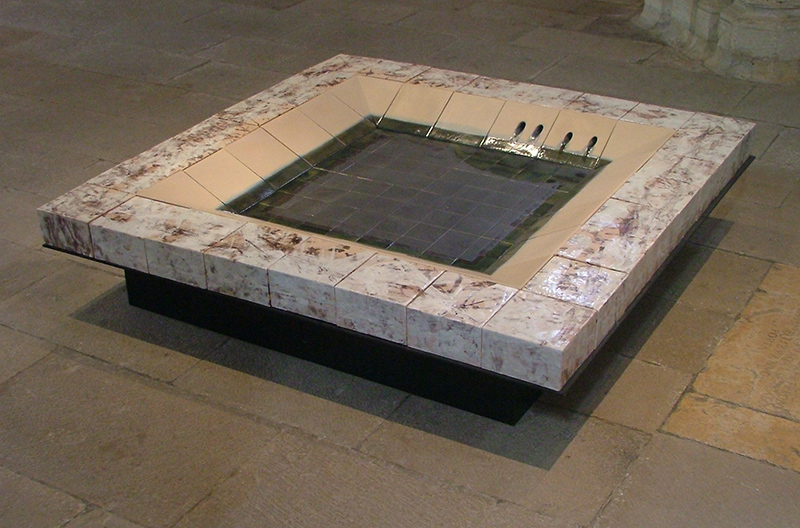A água mostra quem não se vê

Tanque 1, 2002
Faiança com vidrados múltiplos, 1000ºC, 200 x 200 x 15 cm.
(...) A outra virtude da amoreira era projectar sobre um tanque a sombra opaca, que permitia a duas ou três mulheres ainda ali lavarem a roupa de vez em quando, sem se exporem ao sol, que depois das onze horas calca sobre a cabeça e as costas com o peso de um fardo.
Visitávamos esse tanque sazonalmente. Primeiro, por causa das folhas da amoreira, depois, por causa do verão que fazia dele uma zona de tréguas e o colocava na rota de todos os jogos de guerra e perseguições.
O tanque de paredes grossas, argamassadas a cal, com o topo capeado a lajes de cantaria, chanfrado para dentro e marcado por duas pedras de esfregar que lhe sublinhavam o carácter instável do cume, emoldurava uma água que não era limpa nem suja. Só de longe a longe era água transparente sob o verde luminoso da amoreira. O resto dos dias, tinha um corpo ensaboado e leitoso com o cheiro que tem a roupa molhada. Afogava as folhas que se soltavam e nela projectava eu travessias e o confronto com as margens.
Não sei porque é que o tanque era uma tão poderosa instância de afirmação. Se porque para lá chegar tínhamos de iludir “a velha” e a proibição que preservava supostamente a tal água que nunca estava limpa, se a outra autorização que provavelmente zelava pela nossa segurança contra as paredes escorregadias, se simplesmente porque a sua forma vaga de fortaleza filipina lhe conferia um valor simbólico de cidadela.”
The water shows who can't see??
(…) The other virtue of the mulberry tree was to project over the water tank an opaque shade, which allowed two or three women to still wash clothes there, from time to time, without exposing themselves to the sun, which by noon clenches on the head and back, the weight of a bale.
We visited this tank seasonally. First, because of the mulberry leaves – as we fed the silkworms on them, then because of the summer that made it a truces zone putting it on the route of all war games and persecutions.
The thick-walled tank, plastered with lime, topped with stone slabs, beveled inwardly and marked by two scrub stones that underlined the unstable character of the ridge, framed a water that was neither clean nor dirty. Only occasionaly was the water transparente, beneath the bright green of the mulberry tree. The rest of the time, it had a soapy and milky body with the smell of wet clothing. I drown there loosened leaves, and projected on that strange water passages and the confrontation with the banks. I do not know why the tank was such a powerful instance of affirmation. Because to get there we had to deceive "the old woman" and the prohibition that presumably preserved such water, never clean, or if the other permit that probably jeered for our security against the slippery walls, or if simply because its vague shape of Philippine fortress gaved it a symbolic value of citadel. "(…)
Visitávamos esse tanque sazonalmente. Primeiro, por causa das folhas da amoreira, depois, por causa do verão que fazia dele uma zona de tréguas e o colocava na rota de todos os jogos de guerra e perseguições.
O tanque de paredes grossas, argamassadas a cal, com o topo capeado a lajes de cantaria, chanfrado para dentro e marcado por duas pedras de esfregar que lhe sublinhavam o carácter instável do cume, emoldurava uma água que não era limpa nem suja. Só de longe a longe era água transparente sob o verde luminoso da amoreira. O resto dos dias, tinha um corpo ensaboado e leitoso com o cheiro que tem a roupa molhada. Afogava as folhas que se soltavam e nela projectava eu travessias e o confronto com as margens.
Não sei porque é que o tanque era uma tão poderosa instância de afirmação. Se porque para lá chegar tínhamos de iludir “a velha” e a proibição que preservava supostamente a tal água que nunca estava limpa, se a outra autorização que provavelmente zelava pela nossa segurança contra as paredes escorregadias, se simplesmente porque a sua forma vaga de fortaleza filipina lhe conferia um valor simbólico de cidadela.”
Tese de Mestrado em Pintura, FBAUL, 2004.
The water shows who can't see??
(…) The other virtue of the mulberry tree was to project over the water tank an opaque shade, which allowed two or three women to still wash clothes there, from time to time, without exposing themselves to the sun, which by noon clenches on the head and back, the weight of a bale.
We visited this tank seasonally. First, because of the mulberry leaves – as we fed the silkworms on them, then because of the summer that made it a truces zone putting it on the route of all war games and persecutions.
The thick-walled tank, plastered with lime, topped with stone slabs, beveled inwardly and marked by two scrub stones that underlined the unstable character of the ridge, framed a water that was neither clean nor dirty. Only occasionaly was the water transparente, beneath the bright green of the mulberry tree. The rest of the time, it had a soapy and milky body with the smell of wet clothing. I drown there loosened leaves, and projected on that strange water passages and the confrontation with the banks. I do not know why the tank was such a powerful instance of affirmation. Because to get there we had to deceive "the old woman" and the prohibition that presumably preserved such water, never clean, or if the other permit that probably jeered for our security against the slippery walls, or if simply because its vague shape of Philippine fortress gaved it a symbolic value of citadel. "(…)
MFA Thesis at FBA-Univ. Lisboa, 2004










